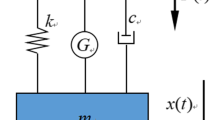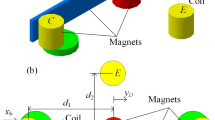Abstract
Vibration energy harvesting has extensive application prospects in many significant occasions, such as mechanical structure health monitoring, vehicle tire pressure monitoring, IoT devices and human health monitoring. The nonlinearity is an effective method to improve the energy harvesting efficiency where there are low- and high-energy orbits in the multi-solution region of the system. The harvested power will be increased significantly when the system is guided from the low-energy orbit to the high-energy orbit. The sliding mode control is regarded as an easy, robust and adaptive method for orbit jump, but the implementation of this nonlinear control method has not been discussed. This paper proposes a high-energy sliding mode control method through rotatable magnets actuated by micro-motor. The electromechanical model of mono-stable and bi-stable systems with the identified nonlinear restoring force is established to design a sliding mode control algorithm for enhancing the energy harvesting performance. Simulation and experiment results demonstrate that the rotatable magnets with sliding mode control have a positive influence on reaching the high-energy orbit for both mono-stable and bi-stable systems within the multi-solution region. Moreover, the rotatable magnets method with a sliding mode control actuates the small magnets in the system for a short time with little theoretical consumption of energy. This research has provided a potential practical application of sliding mode control for high-energy orbit jump of the nonlinear energy harvesting.



























Similar content being viewed by others
Availability of data and material
These data are collected by the experiment.
Code availability
The code is written according to the proposed model.
References
S Nabavi L Zhang 2016 Portable wind energy harvesters for low-power applications: a survey Sensors. 16 1101
Y Zhang J Cao H Zhu Y Lei 2019 Design, modeling and experimental verification of circular Halbach electromagnetic energy harvesting from bearing motion Energy Convers. Manag. 180 811 821
H Fu EM Yeatman 2019 Rotational energy harvesting using bi-stability and frequency up-conversion for low-power sensing applications: Theoretical modelling and experimental validation Mech. Syst. Signal Process. 125 229 244
CR Bowen MH Arafa 2015 Energy harvesting technologies for tire pressure monitoring systems Adv. Energy Mater. 5 1401787
FK Shaikh S Zeadally 2016 Energy harvesting in wireless sensor networks: A comprehensive review Renew. Sustain. Energy Rev. 55 1041 1054
W Wang J Cao N Zhang J Lin W-H Liao 2017 Magnetic-spring based energy harvesting from human motions: design, modeling and experiments Energy Convers. Manag. 132 189 197
C Wei X Jing 2017 A comprehensive review on vibration energy harvesting: modelling and realization Renew. Sustain. Energy Rev. 74 1 18
R Ahmed F Mir S Banerjee 2017 A review on energy harvesting approaches for renewable energies from ambient vibrations and acoustic waves using piezoelectricity Smart Mater. Struct. 26 85031
H-X Zou L-C Zhao Q-H Gao L Zuo F-R Liu T Tan K-X Wei W-M Zhang 2019 Mechanical modulations for enhancing energy harvesting: Principles, methods and applications Appl. Energy. 255 113871
H Fu S Theodossiades B Gunn I Abdallah E Chatzi 2020 Ultra-low frequency energy harvesting using bi-stability and rotary-translational motion in a magnet-tethered oscillator Nonlinear Dyn. 101 2131 2143
W Yang S Towfighian 2017 Internal resonance and low frequency vibration energy harvesting Smart Mater. Struct. 26 95008
N Tran MH Ghayesh M Arjomandi 2018 Ambient vibration energy harvesters: a review on nonlinear techniques for performance enhancement Int. J. Eng. Sci. 127 162 185
RT Rocha JM Balthazar AM Tusset SLT Souza de FC Janzen HC Arbex 2019 On a non-ideal magnetic levitation system: nonlinear dynamical behavior and energy harvesting analyses Nonlinear Dyn. 95 3423 3438
L-C Zhao H-X Zou G Yan F-R Liu T Tan W-M Zhang Z-K Peng G Meng 2019 A water-proof magnetically coupled piezoelectric-electromagnetic hybrid wind energy harvester Appl. Energy. 239 735 746
C Liu X Jing 2016 Vibration energy harvesting with a nonlinear structure Nonlinear Dyn. 84 2079 2098
M Pozzi 2016 Magnetic plucking of piezoelectric bimorphs for a wearable energy harvester Smart Mater. Struct. 25 45008
S Zhou J Cao J Lin 2016 Theoretical analysis and experimental verification for improving energy harvesting performance of nonlinear monostable energy harvesters Nonlinear Dyn. 86 1599 1611
RL Harne KW Wang 2013 A review of the recent research on vibration energy harvesting via bistable systems Smart Mater. Struct. 22 23001
J Kim P Dorin KW Wang 2020 Vibration energy harvesting enhancement exploiting magnetically coupled bistable and linear harvesters Smart Mater. Struct. 29 65006
S Zhou J Cao DJ Inman J Lin S Liu Z Wang 2014 Broadband tristable energy harvester: modeling and experiment verification Appl. Energy. 133 33 39
A Erturk J Hoffmann DJ Inman 2009 A piezomagnetoelastic structure for broadband vibration energy harvesting Appl. Phys. Lett. 94 254102 254105
SC Stanton CC McGehee BP Mann 2009 Reversible hysteresis for broadband magnetopiezoelastic energy harvesting Appl. Phys. Lett. 95 174103
L Tang Y Yang 2012 A nonlinear piezoelectric energy harvester with magnetic oscillator Appl. Phys. Lett. 101 94102
C Lan W Qin 2017 Enhancing ability of harvesting energy from random vibration by decreasing the potential barrier of bistable harvester Mech. Syst. Signal Process. 85 71 81
H-X Zou W-M Zhang W-B Li K-M Hu K-X Wei Z-K Peng G Meng 2017 A broadband compressive-mode vibration energy harvester enhanced by magnetic force intervention approach Appl. Phys. Lett. 110 163904
K Yang J Wang D Yurchenko 2019 A double-beam piezo-magneto-elastic wind energy harvester for improving the galloping-based energy harvesting Appl. Phys. Lett. 115 193901
S Zhou J Cao A Erturk J Lin 2013 Enhanced broadband piezoelectric energy harvesting using rotatable magnets Appl. Phys. Lett. 102 173901
J Cao S Zhou W Wang J Lin 2015 Influence of potential well depth on nonlinear tristable energy harvesting Appl. Phys. Lett. 106 173903
G Sebald H Kuwano D Guyomar B Ducharne 2011 Simulation of a Duffing oscillator for broadband piezoelectric energy harvesting Smart Mater. Struct. 20 75022
G Sebald H Kuwano D Guyomar B Ducharne 2011 Experimental Duffing oscillator for broadband piezoelectric energy harvesting Smart Mater. Struct. 20 102001
C Lan L Tang W Qin 2017 Obtaining high-energy responses of nonlinear piezoelectric energy harvester by voltage impulse perturbations Eur. Phys. Journal-applied Phys. 79 20902
L Yan M Lallart A Karami 2019 Low-cost orbit jump in nonlinear energy harvesters through energy-efficient stiffness modulation Sens. Actuators A Phys. 285 676 684
Wang, J., Zhao, B., Liang, J., Liao, W.-H.: Orbit jumps of monostable energy harvesters by a bidirectional energy conversion circuit. In: ASME 2019 International Design Engineering Technical Conferences and Computers and Information in Engineering Conference (2019)
D Mallick A Amann S Roy 2016 Surfing the high energy output branch of nonlinear energy harvesters Phys. Rev. Lett. 117 197701
J Wang W-H Liao 2019 Attaining the high-energy orbit of nonlinear energy harvesters by load perturbation Energy Convers. Manag. 192 30 36
A Erturk DJ Inman 2011 Broadband piezoelectric power generation on high-energy orbits of the bistable Duffing oscillator with electromechanical coupling J. Sound Vib. 330 2339 2353
S Zhou J Cao DJ Inman S Liu W Wang J Lin 2015 Impact-induced high-energy orbits of nonlinear energy harvesters Appl. Phys. Lett. 106 93901
T Huguet M Lallart A Badel 2019 Orbit jump in bistable energy harvesters through buckling level modification Mech. Syst. Signal Process. 128 202 215
Y Huang W Liu Y Yuan Z Zhang 2020 High-energy orbit attainment of a nonlinear beam generator by adjusting the buckling level Sens. Actuators A Phys. 312 112164
E Ott C Grebogi JA Yorke 1990 Controlling chaos Phys. Rev. Lett. 64 1196
D Geiyer JL Kauffman 2015 Chaotification as a means of broadband energy harvesting with piezoelectric materials J. Vib. Acoust. 137 51005
Geiyer, D., Kauffman, J.L.: Control between coexistent attractors for optimal performance of a bistable piezoelectric vibration energy harvester. In: SPIE Smart Structures and Materials + Nondestructive Evaluation and Health Monitoring (2016)
A Kumar SF Ali A Arockiarajan 2016 Enhanced energy harvesting from nonlinear oscillators via chaos control IFAC-PapersOnLine 49 35 40
AH Hosseinloo J-J Slotine K Turitsyn 2018 Robust and adaptive control of coexisting attractors in nonlinear vibratory energy harvesters J. Vib. Control. 24 2532 2541
A Yousefpour AH Hosseinloo MRH Yazdi A Bahrami 2020 Disturbance observer–based terminal sliding mode control for effective performance of a nonlinear vibration energy harvester J. Intell. Mater. Syst. Struct. 31 1495 1510
SC Stanton CC McGehee BP Mann 2010 Nonlinear dynamics for broadband energy harvesting: investigation of a bistable piezoelectric inertial generator Phys. D Nonlinear Phenom. 239 640 653
A Erturk 2012 Assumed-modes modeling of piezoelectric energy harvesters: Euler–Bernoulli, Rayleigh, and Timoshenko models with axial deformations Comput. Struct. 106 214 227
Y Zhang J Cao W Wang W-H Liao 2021 Enhanced modeling of nonlinear restoring force in multi-stable energy harvesters J. Sound Vib. 494 115890
J-F Charpentier G Lemarquand 1999 Optimal design of cylindrical air-gap synchronous permanent magnet couplings IEEE Trans. Magn. 35 1037 1046
Acknowledgements
This study is supported by the National Natural Science Foundation of China (Grant No. 51975453).
Funding
National Natural Science Foundation of China (Grant No. 51975453).
Author information
Authors and Affiliations
Corresponding author
Ethics declarations
Conflict of interest
The authors declare that they have no conflict of interest.
Additional information
Publisher's Note
Springer Nature remains neutral with regard to jurisdictional claims in published maps and institutional affiliations.
Appendix 1: Nonlinear restoring force calculation for multi-stable energy harvester
Appendix 1: Nonlinear restoring force calculation for multi-stable energy harvester
According to the research [48] on the restoring force modeling, the force condition of tip magnet in given configuration is shown in Fig.
28. The nonlinear restoring force here is along y direction.
The governing equation of tip magnet along y and z directions can be obtained as:
where Fmy, Fmz are magnetic force along y direction and z direction, respectively; Fe1 is elastic force along y direction; Fe2 is the elastic force of cantilever beam along axial direction; Fg is the gravity force of tip magnets; Fr is the nonlinear restoring force.
In order to solve Eq. (20) to obtain the nonlinear restoring force, it is necessary to calculate the magnetic force between the tip magnet and the external magnets. The detailed expression of magnetic force between two cubic magnets can be seen in the research [49]. In terms of two cubic magnets with the magnetization J, the size is a × b × c and a′ × b′ × c′ along x, y and z directions, respectively. The relative coordinates between these two magnets are (x01, y01, z01), and relative rotational angle along x direction is θ.
The magnetic force along z direction is
When θ ≠ kπ, it has
When θ = kπ, it has
Then, the magnetic force along y direction is
Rights and permissions
About this article
Cite this article
Zhang, Y., Ding, C., Wang, J. et al. High-energy orbit sliding mode control for nonlinear energy harvesting. Nonlinear Dyn 105, 191–211 (2021). https://doi.org/10.1007/s11071-021-06616-8
Received:
Accepted:
Published:
Issue Date:
DOI: https://doi.org/10.1007/s11071-021-06616-8





